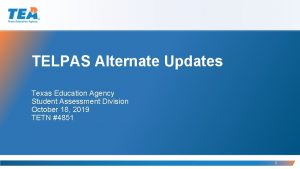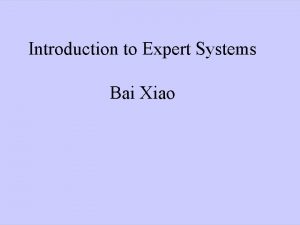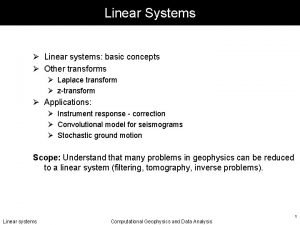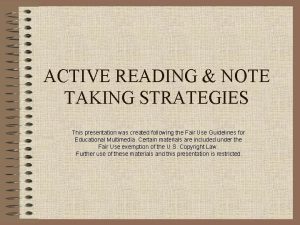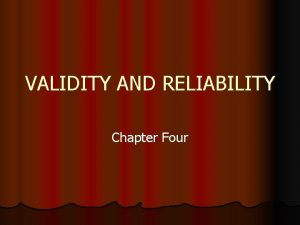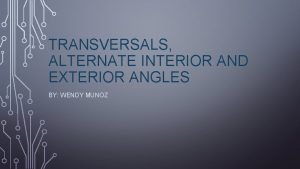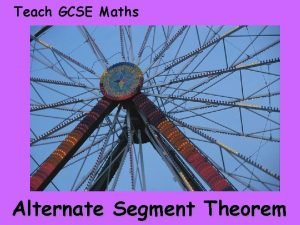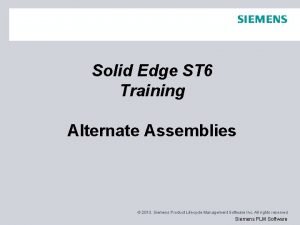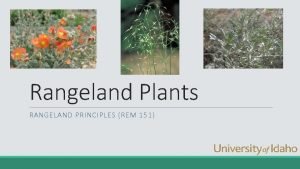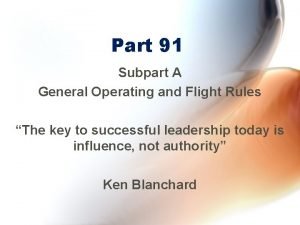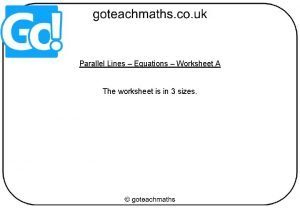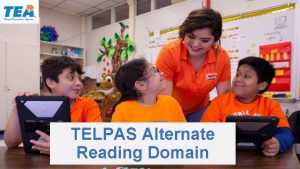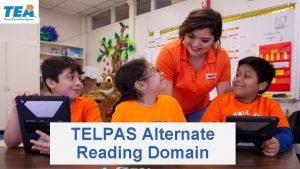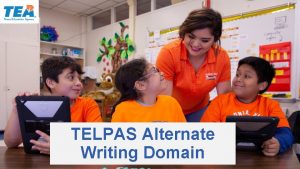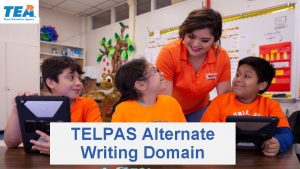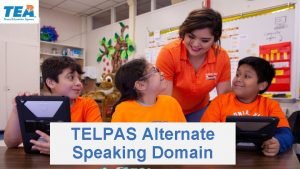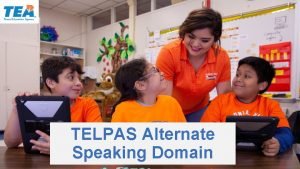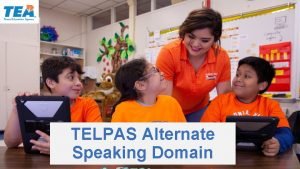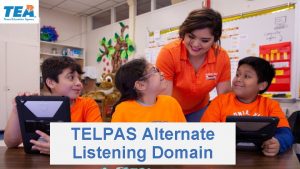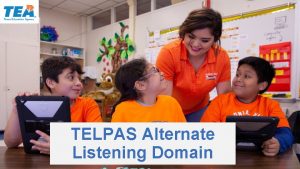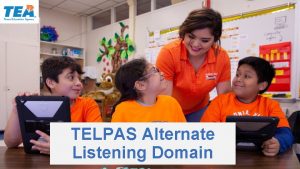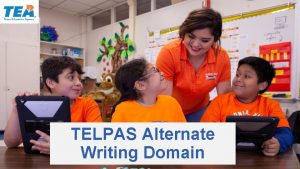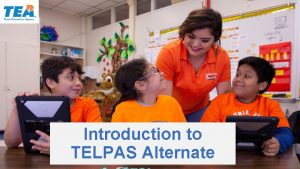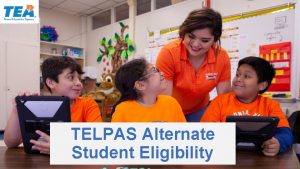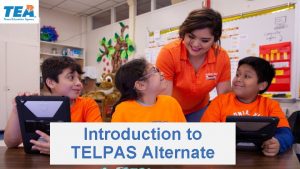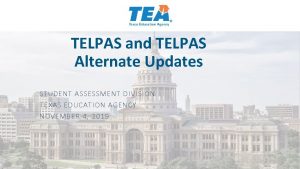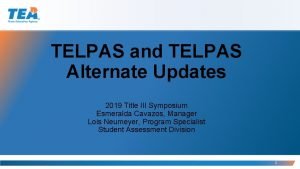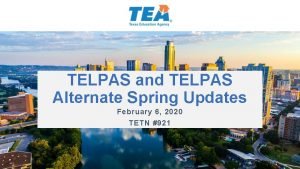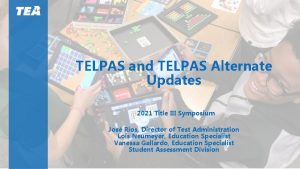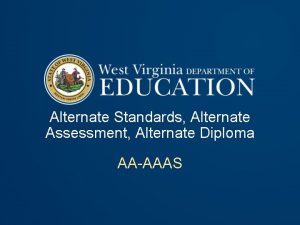TELPAS Alternate Reading Domain Purpose of this TELPAS






























- Slides: 30

TELPAS Alternate Reading Domain

Purpose of this TELPAS Alternate Training • Intended for classroom teachers who will be administering TELPAS Alternate during the testing window § Can be used by others (e. g. , test coordinators, administrators, parents) as needed in order to clarify different aspects of this testing program • Explains the Alternate Proficiency Level Descriptors and Observable Behaviors for Reading • Provides classroom examples of the Reading Observable Behaviors • Describes ways to make the Reading Observable Behaviors more accessible for students Texas Education Agency 2018 -2019 School Year 2

Alternate Proficiency Level Descriptors • TELPAS Alternate is a holistic inventory aligned to the Texas English Language Proficiency Standards (ELPS). • This inventory is based on alternate Proficiency Level Descriptors (PLDs) that were created to address the specific access needs of English learners with significant cognitive disabilities. • The PLDs can be used to better understand the intent and scope of specific Observable Behaviors. • The PLDs can be used to provide a summary of a student’s general English reading ability after scoring. Texas Education Agency 2018 -2019 School Year 3

Alternate Proficiency Level Descriptors: Reading Texas Education Agency 2018 -2019 School Year 4

What are Observable Behaviors? • In TELPAS Alternate, the Observable Behaviors are like questions the test administrator answers about a student. Each Observable Behavior measures one skill that is aligned to the ELPS. The skill can be found on the left under the number of the Observable Behavior. The boxes contain descriptions of characteristics that students learning English are likely to demonstrate over time. The descriptors show the progression of second language acquisition from one proficiency level to the next and are aligned to the TELPAS Alternate PLDs. • A “notes version” of the Observable Behaviors can be found on TEA’s TELPAS Alternate Resources web page. It is available so that educators can become familiar with the Observable Behaviors and practice using them during the school year. Texas Education Agency 2018 -2019 School Year 5

Observable Behaviors and the Glossary You may discover vocabulary in the Observable Behaviors that might be used in a way that differs from common classroom usage. The TELPAS Alternate Test Administrator Manual includes a glossary with terms specific to this assessment that may assist you. Texas Education Agency 2018 -2019 School Year 6

Observable Behaviors with Classroom Examples • Texas teachers developed classroom examples to help test administrators better understand the descriptions of student performance for each Observable Behavior. • Elementary and secondary examples describe one way that students could demonstrate each skill across the five levels of proficiency. An accessible version of the Observable Behaviors and classroom examples can be found at https: //tea. texas. gov/student. assessment/telpasalt/#Alt Texas Education Agency 2018 -2019 School Year 7

Using the Classroom Examples • The purpose of each example is to illustrate how a student could demonstrate the skill at each proficiency level. • There are many other classroom activities that could be used as examples for the Observable Behaviors. • These examples are not intended to be used as test questions or performance tasks for teachers to replicate, although using them for this purpose is acceptable if needed. • Teachers are encouraged to use their own activities in the regular classroom setting when determining a student’s ability to understand use English. Texas Education Agency 2018 -2019 School Year 8

Observable Behavior R 1. Understanding Letter. Sound Relationships with Classroom Examples Elementary Student shows no response when teacher matches the letter c to the word/picture card “cat. ” After teacher modeling, student selects two cards that begin with the same letter. Teacher shows student a ball and asks “What sound does this start with? ” Student indicates the sound for b. Teacher shows student word/picture cards for “green” and “grape. ” Teacher asks what sound the words on the card make. Student indicates gr. Teacher shows student word/picture cards for “shop” and “shoe. ” Teacher asks what sound the words on the card make. Student indicates sh. Secondary Student attends to the teacher matching the letter b to the word “broccoli” on a shopping list. Given an item on the shopping list, student locates other items on the list beginning with the same sound. Provided with a picture or object from a shopping list, student produces the initial letter sound. Provided with a shopping list picture or object beginning with a consonant blend, student produces the initial consonant blend sound. Provided with a shopping list picture or object beginning with a digraph, student produces the initial diagraph sound. Texas Education Agency 2018 -2019 School Year 9

Observable Behavior R 2. Decoding with Classroom Examples Elementary Teacher reads a familiar story to student and points to the word and picture of “cat” and says “cat. ” Student then touches teacher and smiles. Student matches a word/picture combination of “cat” to an identical word/ picture combination of “cat. ” Teacher asks student to Student reads the phrase Student reads the find the word “cat. ” “fast black cat” sentence “The cat jumps Student locates the word independently. on the sofa. ” “cat” from a group of words Secondary Teacher reads a word/ picture combination of a familiar staff member “Mr. Smith” and says “Mr. Smith. ” The student touches the picture. Student matches a word/picture combination of “Mr. Smith” to an identical word/picture combination of “Mr. Smith. ” Teacher asks student to find the words “Mr. Smith. ” Student locates the words “Mr. Smith” from a group of other familiar staff members’ names. Texas Education Agency 2018 -2019 School Year Student reads the words “Mr. Smith” and “bus” from the sentence “Mr. Smith drives the bus. ” Student reads the sentence “Mr. Smith drives the bus for our field trip. ” 10

Observable Behavior R 3. Developing Sight Vocabulary with Classroom Examples Elementary Teacher presents a word/picture combination of “tiger. ” Student walks away. Teacher reads a book to student with the word “tiger” in it. Teacher then presents a word/picture combination of “tiger” to student. Student matches the word/ picture combination of “tiger” to an identical word/picture combination of “tiger. ” Teacher presents the word cards “tiger, ” “dog, ” and “bird” and asks student to find the “tiger. ” Student locates “tiger. ” Student reads the phrase “big orange tiger” from the sentence “The big orange tiger has black stripes. ” Student reads the sentence “Tigers hunt for food at night. ” Secondary Teacher presents a word/picture combination of “water. ” Student walks away. Teacher reads a book about animals that live in the water. Teacher then presents a word/picture combination of “water” to student. Student matches the word/picture combination of “water” to an identical word/picture combination of “water. ” Students play vocabulary bingo about animals that live in the water. Teacher displays the vocabulary card “shark” and student locates and marks the appropriate words found on his or her card. Student reads the phrase “sharks eat“ and “fish” from the sentence “Sharks eat many different kinds of fish. ” Student reads the phrase “water moves over the gills” from the sentence “Sharks breathe when oxygen is absorbed as water moves over the gills. ” Texas Education Agency 2018 -2019 School Year 11

Observable Behavior R 4. Understanding Environmental Print with Classroom Examples Elementary Student turns away when presented with a picture of food items labeled “fruit” on a classroom poster about healthy food. Student selects a word/picture combination titled “fruit” from a group of word/picture combinations when presented with an identical titled picture of “fruit. ” Teacher presents student with a picture of fruit. Student selects the printed word “fruit” from a group of other simple printed words. Student reads the printed words “fruits” and “vegetables” on a classroom poster about healthy food. Student selects the printed word for “healthy” and “balanced diet” from a classroom poster about healthy food. Secondary Student looks at the printed word for “computer” when shown a picture of a computer. Student selects the picture titled “computer” from a group of word/picture combinations when presented with an identical titled picture of a computer. Student selects the printed word “computer” from a group of other simple printed words when presented with a picture of a computer. Student reads the words “computer, ” “mouse, ” and “keyboard” from labels around the computer lab. Student reads the printed words “technology” and “software” from the word wall in the classroom. Texas Education Agency 2018 -2019 School Year 12

Observable Behavior R 5. Visual and Textual Supports with Classroom Examples Elementary Teacher reads a text about nutrition to student and points to a labeled picture of vegetables. Student smiles. Teacher reads a text about nutrition to the student. Teacher points to a labeled picture of a carrot. Student matches the labeled picture with a similar word/picture combination of a carrot. Teacher shows a visual representing a carrot growing in the ground with the stem, soil, and leaves labeled and reads the labels. Teacher says “point to the word ‘leaves. ’” Student points to the word “leaves” in the diagram. Student is given the printed sentence “Carrots have __, stems, and __. ” Student selects “leaves” and “roots” from a word bank to complete the sentence. Student is given the printed sentence “Carrots are __ that are good for your __. ” Student independently completes the sentence using recently learned content-based vocabulary by adding “vegetables” and “eyes. ” Secondary Teacher reads a text about going to the bank and points to a labeled picture of coins. Student looks away. Teacher reads a text about going to the bank. Teacher points to a labeled picture of a penny. Student matches the labeled picture of a penny to a similar word/picture combination of a penny. Teacher shows a visual representing different labeled coins and reads the labels. Teacher says “point to the word ‘penny. ’” Student points to the word “penny” in the visual. Student fills in sentences like “A __ is worth one cent, ” “A __ is worth five cents, ” “A __ is worth ten cents, ” and “A __ is worth twenty-five cents” from a word bank to complete the sentences. Student is given the printed sentence “You should __ your money in a __ and not spend it all. ” Student independently completes the sentence using recently learned content-based vocabulary by adding “save” and “bank. ” Texas Education Agency 2018 -2019 School Year 13

Observable Behavior R 6. Participating in Shared Reading with Classroom Examples Elementary Teacher reads The Very Hungry Caterpillar to the student. Student looks at his hand smiles. Student echoes words from a predictable text in multiple choral reads of the text. Teacher pauses during read aloud, and student supplies the name of the food on each page. Teacher rereads The Very Hungry Caterpillar to student and pauses throughout the book, allowing student to say the repeated predictable missing phrases. Teacher provides student with the book The Very Hungry Caterpillar and allows student to partner read each page individually with teacher support when needed. Secondary Student listens to a story about football that frequently repeats words and phrases. Student reaches for the book. Student follows with his or her finger a story about football that frequently repeats words and phrases during multiple choral reads of the text. Teacher pauses during read aloud of a story about football that frequently repeats words and phrases. Student says “football” and “touchdown” as appropriate for the story. Teacher rereads a story about football that frequently repeats words and phrase and pauses throughout the book, allowing student to say the repeated predictable missing phrases. Teacher provides student with a story about football that frequently repeats words and phrases and allows student to partner read each page individually with teacher support when needed. Texas Education Agency 2018 -2019 School Year 14

Observable Behavior R 7. Understanding Ideas/ Details in Graphic Sources with Classroom Examples Elementary Student is presented with a recipe with icons for each step in the cooking activity. Student visually explores the recipe when directed. After viewing a step in the recipe, the student matches a photograph of eggs to an icon of eggs in the recipe. Student selects from the printed words “add, ” “bake, ” or “mix” to indicate the next action needed to complete the recipe. Student reads the verb phrase from the recipe for the next action needed to complete the recipe. (e. g. , “pour the milk, ” “stir the mix, ” “roll the dough. ”) Student identifies the sentences in the recipe that tell about units of measurement. Secondary Teacher presents a map of Texas with landforms. Student continues to look at other students and smiles. Teacher presents picture cards of different landforms. Teacher shows a mountain to the student and ask the student to find another mountain. Student finds another mountain from a group of picture cards. During group discussion, teacher asks student to describe the mountain. Student selects the words “tall” and “pointy. ” Student reads the phrases “Hill Country” and “Gulf Coast” from a map of Texas. Teacher presents student with a short text and a map about the landforms in Texas. Student uses the map and sentences from the text in order to describe Coastal Plains. Texas Education Agency 2018 -2019 School Year 15

Observable Behavior R 8. Identifying the Main Idea/Details with Classroom Examples Elementary Teacher presents an adapted version of the book Cloudy With a Chance of Meatballs. Teacher shows premade word/picture cards of the important illustrations from the book. Student pays close attention to teacher. Teacher presents a labeled picture of the main character. Teacher asks student to find the same character from a group of characters. Student points to a matching labeled picture card. Teacher asks “Who is the main character in the story? ” Teacher shows three labeled picture cards to student. Student chooses the main character. Student reads a short section of the book. Teacher asks “What color was the tomato tornado? ” Student says “red. ” Student reads several pages of the book. Teacher asks “Why did Flint Lockwood make his invention? ” Student responds with reasons found within the story. Secondary Teacher presents an adapted graphic novel about a superhero. Teacher shows premade word/picture cards of the important illustrations from the novel. Student pays close attention to teacher. Teacher presents a labeled picture of the main character. Teacher asks student to find the same character from a group of characters. Student points to a matching labeled picture card. Teacher asks “Where did the story mostly take place? ” Teacher shows student three labeled picture cards. Student chooses “city. ” Student reads a short section of the graphic novel. Teacher asks “What are the hero’s superpowers? ” Student says “fly” and “x-ray vision. ” Student reads several pages of the graphic novel. Teacher asks “How did the superhero save the city? ” Student responds with ideas found within the story. Texas Education Agency 2018 -2019 School Year 16

Observable Behavior R 9. Making Predictions with Classroom Examples Elementary Teacher presents If You Give a Mouse a Cookie to student. Teacher shows premade word/picture cards with the sequence of events from the story. Student claps and pays close attention to teacher. Teacher pauses while reading and models making a prediction by choosing a word/picture card representing what will happen. Student chooses the word/ picture combination that matches the prediction. Teacher pauses while reading and asks “What do you think the mouse will ask for next? ” Student selects the word “milk” from a group of words. Student reads an adapted text of If You Give a Mouse a Cookie. Teacher presents word/picture cards with short phrases such as “ask for cookie, ” “ask for milk, ” and “ask for straw. ” Student chooses the phrase that predicts the next event. Student reads adapted text. Teacher presents three sentences describing what the mouse might request next. Student chooses the sentence that predicts what will happen next in the story. Secondary Teacher reads a simple social story about making a new friend. Student follows along by viewing the word/picture cards associated with the story. Teacher pauses while reading and models making a prediction by choosing a word/picture card representing what will happen. Student chooses the word/ picture combination that matches the prediction. Teacher pauses while reading and asks “What do you think should happen next? ” The student selects the word “handshake” from a group of words. Student reads a section of a simple social story. Teacher presents word/picture cards with short phrases such as “take turns talking, ” “ask questions, ” and “face the person. ” Student chooses the phrase that predicts the next event. Student reads a section of a simple social story about friends being together. Teacher presents three sentences describing what could happen next. Student chooses the sentence to predict what will happen next in the story. Texas Education Agency 2018 -2019 School Year 17

Observable Behavior R 10. Making Connections between Ideas with Classroom Examples Elementary Teacher reads aloud an excerpt of First Day Jitters. Teacher shares that he or she sometimes gets nervous on the first day of school. Student looks at and plays with a marker. Teacher shows a picture of the book character being nervous for school and points to several emotion cards on the table. Teacher asks “What other character looks nervous? ” Student points to emotion card for nervous. Teacher reads and presents illustrations from On the First Day of Kindergarten and First Day Jitters, along with emotion picture cards. Teacher asks student to select the emotion shown in both books. Student picks the “nervous” card. After student reads short adapted versions of On the First Day of Kindergarten and First Day Jitters, teacher asks “How did the characters feel at the end? ” Student responds with “happy. ” After student reads short adapted versions of On the First Day of Kindergarten and First Day Jitters, two students discuss through “thinkpair-share” how they might feel on the first day of school. Secondary During a reading of an informational text about chores, teacher presents a picture card of a messy room. Teacher shares that a messy room makes it difficult to find things. Student nods. Student is presented with a set of picture cards representing chores. Student locates the picture card of the chore being read about in the text. After the teacher reads a pair of texts about chores, student selects cards representing chores presented in both texts. After the student reads two short texts about chores, the student tells which chores appeared in both texts. After the student reads two texts about chores, student describes which of the chores from the two texts he or she does at home. Texas Education Agency 2018 -2019 School Year 18

How to Determine Student Proficiency for Each Observable Behavior 1. Test administrators should consider only one Observable Behavior at a time. 2. Test administrators will read the skill and think about recent opportunities the student has had to practice that skill. Then test administrators will read the five descriptions of student performance for the Observable Behavior and use their current knowledge and observations of the student’s English language skills to make individual holistic judgments. Texas Education Agency 2018 -2019 School Year 19

How to Determine Student Proficiency for Each Observable Behavior, continued 3. Test administrators must consider the ability of each EL to use English in the domain of reading in the context of skills the student is learning and practicing in a classroom setting. § Think about how well the student has demonstrated the ability to understand or use English in the context of skills the student is learning. § Think about how well the student is able to understand or use English when practicing these skills in a classroom setting. 4. Select the description that closely matches the student’s performance most consistently. § Consistently: almost always acting, behaving, or responding in the same way Texas Education Agency 2018 -2019 School Year 20

On the Border • There is an early, a middle, and a late stage within each TELPAS Alternate proficiency level. Students in the early stage of a proficiency level might demonstrate language that drops down into the previous level at times, especially when working with academic language or new vocabulary and language structures. • Similarly, students in the late stage of a proficiency level will sometimes demonstrate language that reaches into the next level. • For each Observable Behavior, test administrators must consider the description that applies to each student most consistently. Demonstrating a new skill once or even occasionally does not mean a student has crossed over into a higher level of proficiency. Texas Education Agency 2018 -2019 School Year 21

Collaboration • For students who are in the very early or very late stage of a level, it is recommended that test administrators § collaborate with others or ask others familiar with the students for input, and § wait until later in the assessment window to see whether a couple of additional days of observation will help clarify the most appropriate description. Texas Education Agency 2018 -2019 School Year 22

Example of Rating a Student “On the Border”: Milo Ms. Candy has been working with Milo on improving his basic understanding of stories she reads to the class. She sees in her notes that he demonstrates some inconsistency in this skill. In the first semester, he was successfully using picture/word combinations to answer detail questions. Early in the spring, it looked like he was moving towards answering questions without needing the picture/word cards, but she isn’t sure if this behavior is consistent. She asks two assistants in her room for their observations. They confirm that Milo is inconsistent in his ability to demonstrate basic understanding without picture/word combinations. 23

Example of Rating a Student “On the Border”: Bella Mrs. Marshall has been reviewing information about one of her students, Bella. Mrs. Marshall refers to some observations she has made. In her first note from the fall, she is reminded that Bella was decoding short simple phrases consistently. Mrs. Marshall sees a difference beginning with her January note. Starting in the second semester, Bella’s decoding skills seem more sophisticated. She is beginning to independently read short sentences. Many of the words they contain are high frequency, but she is showing the ability to decode some unfamiliar words as well. Mrs. Marshall thinks that Bella has reached the highest level on this Observable Behavior. 24

Alternate Response Modes • For TELPAS Alternate, “English” is more inclusive to allow for all modes of communication in English. • Some English learners use sign language, braille, or another method of communication as a substitute for traditional English in one or more language domains. • Test administrators should allow students to use one or more alternate response modes on the following slide if the students regularly use the response mode(s) during instruction and in accordance with the individualized education program (IEP). • Alternate response modes are only intended for students who cannot listen, speak, read, or write in a traditional way. They are intended to address the communication needs of students based on their disability. Texas Education Agency 2018 -2019 School Year 25

Allowable Response Modes for the Reading Domain For the reading domain, it is allowable for a student to § § § § § read alert to gaze at point to reach for touch or pick up draw circle nod gesture toward the targeted stimulus Texas Education Agency § verbalize or sign by responding to letters, words, or numbers to form a response when a wide range of manipulatives are available § arrange letters, words, or numbers to form responses when a wide range of manipulatives are available § form responses with the assistance of a communication device with preprogrammed familiar vocabulary or programmed student vocabulary § indicate yes or no when presented with three or more choices and being asked, “Is this the ___? ” 2018 -2019 School Year 26

Prompting Versus Leading • • • Prompting is an action intended to initiate or continue a task that the student is being requested to complete. A prompt pulls the student through each step to the end of the task. Leading is asking the student to respond in a specific way or with a specific answer. Leading is NOT allowed. Prompting is allowed for rating the Observable Behaviors on the TELPAS Alternate assessment. § The purpose of TELPAS Alternate is to accurately measure a student’s ability to understand use English to engage in social and academic learning environments. § Prompting a student to respond to a task so that his or her ability to understand or use English can be accurately measured is acceptable. Texas Education Agency 2018 -2019 School Year 27

Available TELPAS Alternate Training Power. Points q Introduction to TELPAS Alternate q Reading Domain q Writing Domain q Student Eligibility q Accessibility q Listening Domain q Speaking Domain Texas Education Agency q Test Administration 2018 -2019 School Year 28

Contact Information TEA’s Student Assessment Division 512 -463 -9536 assessment. specialpopulations@tea. texas. gov Pearson’s Customer Service Center 800 -627 -0225 Tx. Pearson. Access@support. pearson. com Texas Education Agency 2018 -2019 School Year 29

Disclaimer These slides have been prepared by the Student Assessment Division of the Texas Education Agency. You are encouraged to use them for local training. If any of the slides are changed for local use, please hide or remove any TEA logos, headers, or footers. (You may need to edit the Master slide. ) In addition, you must remove the photographs. Only TEA has parental permission to use these photographs for training purposes. This training is not intended to replace any materials or additional information on the TEA website. Texas Education Agency 2018 -2019 School Year 30
 Telpas definition
Telpas definition While reading activities
While reading activities Codomain
Codomain Z domain to frequency domain
Z domain to frequency domain What is time domain and frequency domain
What is time domain and frequency domain Time reversal property of z transform
Time reversal property of z transform Z domain to frequency domain
Z domain to frequency domain Domain specific vs domain general
Domain specific vs domain general Domain specific vs domain general
Domain specific vs domain general Problem domain vs knowledge domain
Problem domain vs knowledge domain S domain to z domain
S domain to z domain A_______ bridges the specification gap between two pls.
A_______ bridges the specification gap between two pls. Contain in a sentence
Contain in a sentence Chapter 5 selecting a topic and a purpose
Chapter 5 selecting a topic and a purpose What is the purpose of the active reading strategy
What is the purpose of the active reading strategy St. louis
St. louis Reading aims
Reading aims Stages of reading skills
Stages of reading skills Definition of guided reading
Definition of guided reading Critical reading words/phrases
Critical reading words/phrases What is extensive reading
What is extensive reading What is intensive reading
What is intensive reading Style of reading
Style of reading Alternate form of reliability
Alternate form of reliability Alternate exterior angles in real life
Alternate exterior angles in real life Prove alternate segment theorem
Prove alternate segment theorem Solid edge alternate assemblies
Solid edge alternate assemblies Common curly mesquite
Common curly mesquite Poesia con onomatopee
Poesia con onomatopee Vfr cloud clearances
Vfr cloud clearances Parallel lines and algebra worksheet
Parallel lines and algebra worksheet
